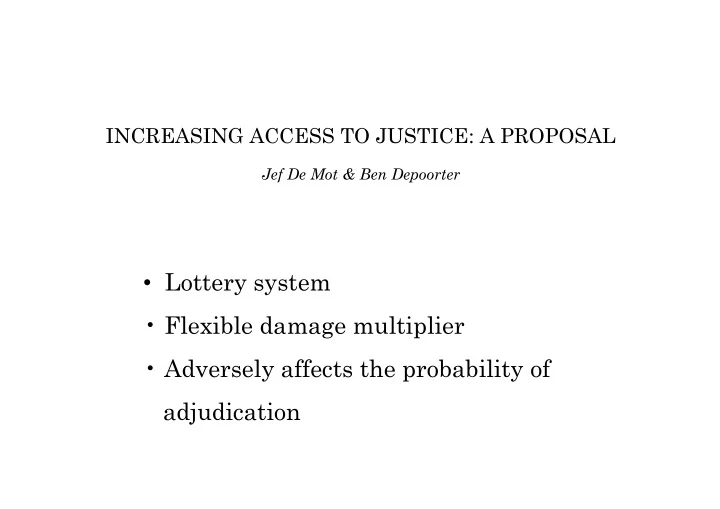

INCREASING ACCESS TO JUSTICE: A PROPOSAL Jef De Mot & Ben Depoorter • Lottery system • Flexible damage multiplier • Adversely affects the probability of adjudication
1. Example - Risk neutral and fixed costs - Three types of plaintiffs: A, B and C - All three have 70 % chance of winning - Amount at stake = 1.000 - Trial costs: A = 500, B = 1.000, C = 2.000 A: 0.7 x 1.000 – 500 = 200 > 0 B: 0.7 x 1.000 – 1.000 = - 300 < 0 C: 0.7 x 1.000 – 2.000 = - 1.300 < 0
1. Example 1. Let plaintiff choose multiplier. Damages are multiplied with that multiplier in case plaintiff wins. For example: plaintiff chooses multiplier of 2 receives 2.000 instead of 1.000 if he wins 2. Courts select randomly with probability inverse to multiplier. If plaintiff chooses 2 50 %, if he chooses 3 33.33 %
1. Example - B now has a credible threat : Suppose he selects a multiplier of 2: ½ x (0.7 x 2.000 – 1.000) + ½ x 0 = 0.7 x 1.000 – 1.000/2 = 200 > 0 - If C chooses a multiplier of 2, his suit still is NEV : ½ x (0.7 x 2.000 – 2.000) + ½ x 0 = 0.7 x 1.000 – 2.000/2 = - 300 > 0 - But if C chooses a multiplier of 3, his suit has PEV : 1/3 x (0.7 x 3.000 – 2.000) + 2/3 x 0 = 0.7 x 1.000 – 2.000/3 = 33 > 0
2. General Without: Pp x J – Cp equal decrease With: Pp x J – Cp/M 1/M x (Pp x M x J – Cp) + (1 – 1/M) x 0
2. General Defendant: EL = 1/M x (Pd x J x M + Cd) = Pd x J + Cd/M Settlement before multiplier has been chosen: between Pp x J – Cp/M and Pd x J + Cd/M.
3. Disadvantages of the proposal 1. Risk costs • Plaintiff: not being selected • Defendant: may have to pay a multiple of the harm he caused • Settlement before plaintiff has choses M • Maximum multiplier • Up to certain value • Linking maximum multiplier to amount at stake
3. Disadvantages of the proposal 2. Increased trial expenditures • Higher amount at stake increased exp. • Risk aversion low multipliers • High multiplier high probability of elimination • Increased trial expenditures increase settlement frequency • Trial expenditures do not increase proportionally
3. Disadvantages of the proposal 3. Frivolous suits • Ask for high multiplier in the hope that case will be randomly selected risk averse defendants may settle • Punishment of frivolous suits • Maximum multiplier/ other measures
3. Disadvantages of the proposal 4. Weak cases • Reduces costs of litigation relative to the gains • Maximum multiplier. • Tying multiplier to the merits of the case
Conclusion - May promote valuable suits - Disadvantages/ eliminated
Recommend
More recommend